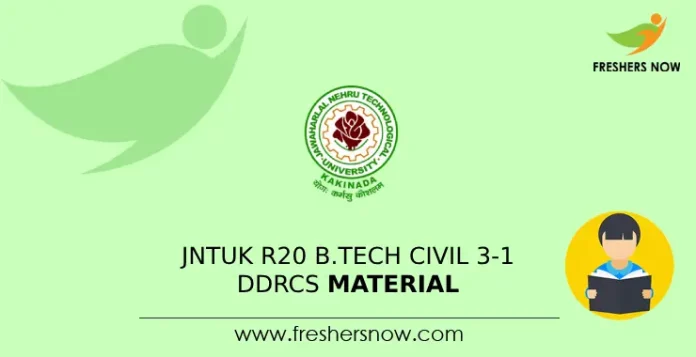
JNTUK R20 B.Tech Civil 3-1 DDRCS Material/ Notes PDF Download: Our meticulously curated material is tailored to meet the objectives outlined by the university. Covering a range of topics, including different design philosophies, the design of flexural members, and concepts of shear, bond, and torsion, our material equips students with the essential knowledge required for reinforced concrete structure design. Additionally, students will familiarize themselves with various types of compression members, footings, and their respective designs. Download the JNTUK R20 B.Tech Civil 3-1 DDRCS Material PDF from the given below links.
JNTUK R20 B.Tech Civil 3-1 DDRCS Material – Units
| No. Of Units | Name of the Unit |
| Unit – 1 | Working Stress Method, Limit State Design |
| Unit – 2 | Design for Flexure and Shear, Design for Shear and Torsion |
| Unit – 3 | Slabs and Serviceability |
| Unit – 4 | Design of Compression Members |
| Unit – 5 | Footings |
Unit 1 Syllabus PDF Download | JNTUK R20 B.Tech Civil 3-1 DDRCS Material
Working Stress Method: Elastic theory: design constants, modular ratio, neutral axis depth, and moment of resistance – balanced, under-reinforced, and over-reinforced sections. Design of singly and doubly reinforced beams, IS Code Provisions.
Limit State Design: Basic statistical principles – Characteristic strength – Characteristic loads – Partial load and safety factors – stress-strain curves for HYSD bars and MS bars. Assumptions – stress block parameters – Moment of Resistance.
| JNTUK R20 B.Tech 3-1 DDRCS Material – PDF Download | |
| To Download JNTUK R20 B.Tech Civil DDRCS Material Unit – 1 PDF | Download PDF |
Unit 2 Syllabus PDF Download | JNTUK R20 B.Tech Civil 3-1 DDRCS Material
Design for Flexure and Shear: Design of singly reinforced beams- effective depthMoment of Resistance- Doubly reinforced and flanged (T) beams- Minimum depth – Minimum and Maximum Flexural Tension Reinforcement – Design of Flanged Sections (T & L)- Effective width of flange – Analysis and Design Problems.
Design for Shear and Torsion: Analysis and design of sections for shear and torsion – bond, anchorage, and development length, I.S. code provisions. Design examples in simply supported and continuous beams, detailing.
| JNTUK R20 B.Tech 3-1 DDRCS Material – PDF Download | |
| To Download JNTUK R20 B.Tech Civil DDRCS Material Unit – 2 PDF | Download PDF |
Unit 3 Syllabus PDF Download | JNTUK R20 B.Tech Civil 3-1 DDRCS Material
Slabs and Serviceability: Classification of slabs, design of one–way slabs, one-way continuous slabs using IS Coefficients (Conventional) –Design of two–way slabs – simply supported slabs and slabs with various edge conditions using IS Coefficients. Design of Staircase Limit state of serviceability: Deflection, cracking, and IS code provisions for beams and slabs.
| JNTUK R20 B.Tech 3-1 DDRCS Material – PDF Download | |
| To Download JNTUK R20 B.Tech Civil DDRCS Material Unit – 3 PDF | Download PDF |
Unit 4 Syllabus PDF Download | JNTUK R20 B.Tech Civil 3-1 DDRCS Material
Design of Compression Members: Effective length, Braced and un-braced columns – IS Code provisions, Design of short and long columns under axial loads, uniaxial bending, and biaxial bending (Demonstration using SP 16).
| JNTUK R20 B.Tech 3-1 DDRCS Material – PDF Download | |
| To Download JNTUK R20 B.Tech Civil DDRCS Material Unit – 4 PDF | Download PDF |
Unit 5 Syllabus PDF Download | JNTUK R20 B.Tech Civil 3-1 DDRCS Material
Footings: Types of footings – Design of isolated footings – pedestal, square, rectangular, and circular footings subjected to axial loads, uni-axial bending moment.
| JNTUK R20 B.Tech 3-1 DDRCS Material – PDF Download | |
| To Download JNTUK R20 B.Tech Civil DDRCS Material Unit – 5 PDF | Download PDF |
JNTUK R20 B.Tech Civil 3-1 Design & Drawing of Reinforced Concrete Structures Notes – Outcomes
- Engage with various design philosophies to cater to different structural requirements effectively.
- Perform comprehensive analysis and design of flexural members, paying attention to detailing for optimal performance.
- Design structures to withstand forces like shear, bond, and torsion, ensuring structural integrity and safety.
- Develop designs for different types of compression members and footings, considering factors like load-bearing capacity and soil characteristics for stable foundations.
For more details about JNTUK R20 B.Tech Civil 3-1 DDRCS Material PDF Download and other materials follow our official website Freshersnow.com.



